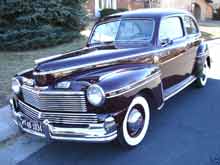Rich Miller recently sent me some photos of his new 1942 Mercury. A low mileage car from Colorado, it benefits from a recent restoration, enhanced by having led a sheltered life. The
ornate dashboard plastic, for example, looks virtually new.
I’ve always had a fascination with 1942 cars. Because the model year was cut short by World War II, few of them saw traffic when new, and fewer still survived to be restored. The Mercury, in particular, had simple, yet elegant, ornamentation.
Its grille showed the horizontal themes becoming popular, but light, almost dainty in execution. After the war,
Mercury’s face became bolder but “busier,” even confused. I started to think about how other cars were transformed during the wartime absence of new models.
Older brother Lincoln also had a thin horizontal grille in
1942, but was given a heavier, grid-like grille for
1946. Ford, which had kept a
vertical grille pattern in 1942, likewise became
bolder in ’46, but went horizontal in a much simpler fashion, with light red accents.
Chrysler also had a
simple, elegant horizontal grille at the onset of war. Like competitor Lincoln, Chrysler “went busy” after the war, adopting a
fine-mesh checkerboard grille that, while not unattractive, lost the gracefulness of the plain chrome bars. DeSoto’s
1946 grille was no busier than the prewar item, but also bolder, and the car sadly lost the unique Airfoil disappearing headlights that had been
’42’s hallmark. Dodge, while not simple in 1942, did have a light,
mostly horizontal grille pattern, but went for
heavy rectangles in 1946, hardly an item of beauty. Plymouth, at least, effected simpler trim after the war, a grille of
alternating width horizontal bars “cleaning up” the prewar kaleidoscope of
shapes and angles.
Almost always the first year of a given design is “purest,” and best stands the test of time. The “freshening” of subsequent seasons soon loses its novelty, and looks like the contrivance it is. One wonders what the 1943 cars would have looked like, had there been a new car season. Would they have looked like the “busy” ’46s, or did the wartime hiatus affect the stylists’ work in more ways than one?
Next week we’ll look how the war affected the rest of the American passenger car industry.

